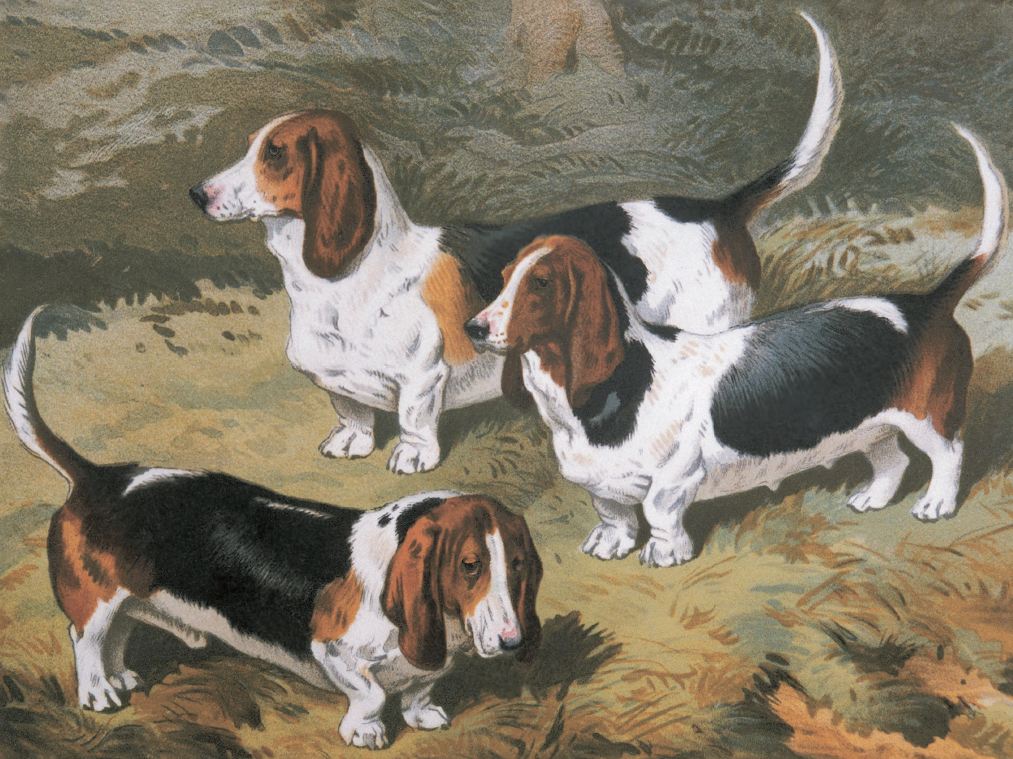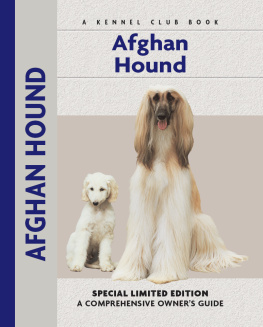Physical Characteristics of the Basset Hound
(from the American Kennel Club breed standard)
Head: Large and well proportioned and of medium width. The skull is well domed, showing a pronounced occipital protuberance.
Eyes: Soft, sad, and slightly sunken, showing a prominent haw, and in color are brown, dark brown preferred.
Muzzle: Deep, heavy, and free from snipiness.

Nose: Darkly pigmented, preferably black, with large wide-open nostrils.
Neck: Powerful, of good length, and well arched.
Lips: Darkly pigmented and pendulous, falling squarely in front and, toward the back, in loose hanging flews.
Ears: Extremely long, low set, and when drawn forward, fold well over the end of the nose. They are velvety in texture, hanging in loose folds with the ends curling slightly inward.
Chest: Deep and full with prominent sternum showing clearly in front of the legs. The distance from the deepest point of the chest to the ground is not to be more than one-third the total height at the withers.
Forelegs: Short, powerful, heavy in bone, with wrinkled skin.
Feet: The paw is massive, very heavy with tough heavy pads, well rounded and with both feet inclined equally a trifle outward, balancing the width of the shoulders.
Tail: Not docked and set in continuation of the spine with but slight curvature, and carried gaily in hound fashion.
Size: The height should not exceed 14 inches.
Body: The rib structure is long, smooth, and extends well back. The ribs are well sprung, allowing adequate room for heart and lungs. The topline is straight, level, and free from any tendency to sag or roach.
Hindquarters: Very full and well rounded, approximately equal to the shoulders in width. The dog stands firmly on its hind legs showing a well-let-down stifle with no tendency toward a crouching stance. The hind feet point straight ahead.
Coat: Hard, smooth, and short, with sufficient density to be of use in all weather. The skin is loose and elastic.
Color: Any recognized hound color is acceptable and the distribution of color and markings is of no importance.

Contents

Trail the ancient origins of the Basset Hound, from vermin-filled regions of France to the British Isles to the open fields of the USA. Meet the breeders and clubs responsible for promoting this marvelous scenthound as a quality pet, show dog and field worker.

Whether your Basset will bring home hare, opossum or just the morning paper, you should learn the essential characteristics of the Basset Hound. A born hunter who is amenable to training, the Basset is an easygoing companion who lives to please his owner and family.

Learn the requirements of a well-bred Basset Hound by studying the description of the breed set forth in the American Kennel Club standard. Both show dogs and pets must possess key characteristics as outlined in the breed standard.

Be advised about choosing a reputable breeder and selecting a healthy, typical puppy. Understand the responsibilities of ownership, including home preparation, acclimatization, the vet and prevention of common puppy problems.

Enter into a sensible discussion of dietary and feeding considerations, exercise, grooming, traveling and identification of your dog. This chapter discusses Basset Hound care for all stages of development.

By Charlotte Schwartz
Be informed about the importance of training your Basset Hound from the basics of housebreaking and understanding the development of a young dog to executing obedience commands (sit, stay, down, etc.).

Discover how to select a qualified veterinarian and care for your dog at all stages of life. Topics include vaccination scheduling, skin problems, dealing with external and internal parasites and common medical and behavioral conditions.

Recognize the signs of an aging dog, both behavioral and medical; implement a senior-care program with your veterinarian and become comfortable with making the final decisions and arrangements for your senior Basset Hound.

Experience the dog-show world, including different types of shows and the making up of a champion. Go beyond the conformation ring to obedience trials, field trials and agility trials and more.

KENNEL CLUB BOOKS BASSET HOUND
ISBN 13: 978-1-59378-261-0
eISBN 13: 978-1-59378-896-4
Copyright 2000 Kennel Club Books An Imprint of I-5 Press A Division of I-5 Publishing, LLC
3 Burroughs, Irvine, CA 92618 USA
Cover Design Patented: US 6,435,559 B2 Printed in South Korea
All rights reserved. No part of this book may be reproduced in any form, by photostat, scanner, microfilm, xerography or any other means, or incorporated into any information retrieval system, electronic or mechanical, without the written permission of the copyright owner.
Photography by Isabelle Franais, with additional photographs by:
Norvia Behling, T. J. Calhoun, Doskocil, T. Fall, Carol Ann Johnson, Bill Jonas, Mikki Pet Products, Alice Roche and Alice van Kempen.
Illustrations by Renee Low.
The publisher would like to thank the following owners, whose dogs appear in this book: Fred & Stella Atwater, Claude & N. Hlne Dlage, Camille Johnson, Jocelyne Pascal, Alice Rand, Kay Rees, Mary Smyzer, Cynthia Wright

Mr. George R. Krehls Basset Hounds, Jupiter, Fino de Paris and Pallas, as they appeared in Cassells Illustrated Book of the Dog, published in 1881.

























